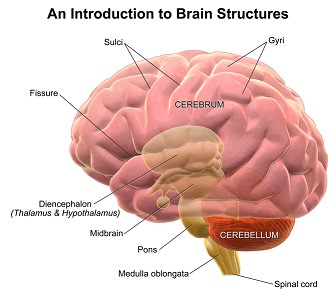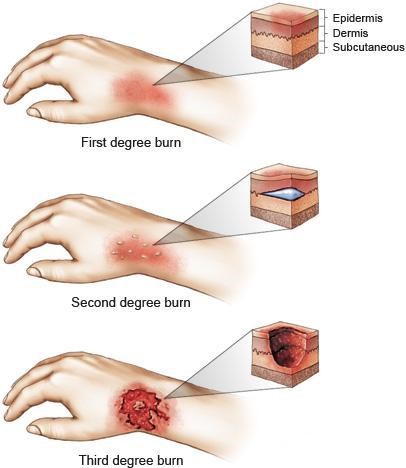A client admitted after a motor vehicle accident arrives with a Glasgow coma score (GCS) of 14 with a mild headache. 4 hours later, the client's GCS has decreased to 10, and now has a dilated pupil on the left side. Which of the following acute traumatic brain injuries does the nurse suspect the client has suffered?
Laceration
Acute subdural hematoma
Intracerebral hemorrhage
Epidural hematoma
The Correct Answer is D
Choice A reason: This is incorrect because laceration is not an acute traumatic brain injury, but a type of wound that involves tearing or cutting of the skin or other tissues. Laceration can occur as a result of a motor vehicle accident, but it does not cause changes in the GCS or pupil size. The nurse should assess the client's skin for any signs of laceration, such as bleeding, swelling, or infection.
Choice B reason: This is incorrect because acute subdural hematoma is not likely to cause a dilated pupil on the left side. Acute subdural hematoma is a type of traumatic brain injury that involves bleeding between the dura mater and the arachnoid mater, which are two layers of the meninges that cover the brain. An acute subdural hematoma can cause a rapid decrease in the GCS, but it usually causes a dilated pupil on the same side as the injury, not on the opposite side.
Choice C reason: This is incorrect because intracerebral hemorrhage is not likely to cause a dilated pupil on the left side. Intracerebral hemorrhage is a type of traumatic brain injury that involves bleeding within the brain tissue itself. Intracerebral hemorrhage can cause a gradual decrease in the GCS, but it usually causes neurological deficits that correspond to the location of the bleeding, such as weakness, numbness, or aphasia, not pupillary changes.
Choice D reason: This is correct because epidural hematoma can cause a dilated pupil on the left side. Epidural hematoma is a type of traumatic brain injury that involves bleeding between the dura mater and the skull. Epidural hematoma can cause a lucid interval, which is a period of normal consciousness followed by a sudden decrease in the GCS, and a dilated pupil on the opposite side of the injury, due to compression of the third cranial nerve. The nurse should notify the provider immediately and prepare for emergency surgery.
Nursing Test Bank
Naxlex Comprehensive Predictor Exams
Related Questions
Correct Answer is D
Explanation
Choice A Reason: This is incorrect because encouraging coughing and deep breathing can increase intracranial pressure (ICP), which is the pressure inside the skull that can affect brain function. Coughing and deep breathing can increase blood flow and oxygen demand to the brain, which can worsen cerebral edema. The nurse should suction the patient as needed and maintain a patent airway.
Choice B Reason: This is incorrect because positioning the patient with knees and hips flexed can increase ICP by reducing venous drainage from the head. The nurse should position the patient with neck and body in alignment and avoid extreme flexion or extension of any joints.
Choice C Reason: This is incorrect because performing nursing interventions once an hour can disturb the patient's sleep and increase ICP by stimulating brain activity. The nurse should cluster nursing interventions and provide quiet and dark environment to promote rest and reduce stress.
Choice D Reason: This is correct because keeping the head of the bed elevated to 30 degrees can decrease ICP by facilitating venous drainage from the head and reducing cerebral blood volume. The nurse should monitor the patient's blood pressure and pulse to ensure adequate cerebral perfusion.

Correct Answer is ["E","F"]
Explanation
Choice A Reason: This is incorrect because submerging the client in a cold bath can cause hypothermia, shock, or infection. Cold water can lower the body temperature and blood pressure, which can impair circulation and organ function. Cold water can also introduce bacteria or contaminants into the open wounds. The nurse should use cool water or saline to gently irrigate the burned areas and then cover them with sterile dressings.
Choice B Reason: This is correct because administering oxygen can help the client breathe better and prevent hypoxia. Burns to the face, neck, or chest can cause swelling or damage to the airway, which can impair gas exchange and oxygen delivery. Oxygen can also reduce the risk of carbon monoxide poisoning, which can occur from inhaling smoke or fumes.
Choice C Reason: This is incorrect because restricting fluids can worsen dehydration and shock. Burns can cause significant fluid and electrolyte loss through evaporation and leakage from damaged capillaries. This can lead to hypovolemia, which is low blood volume, and hypotension, which is low blood pressure. The nurse should monitor the client's vital signs, urine output, and weight, and administer intravenous fluids as ordered.
Choice D Reason: This is incorrect because providing a meal high in fiber can cause abdominal discomfort or diarrhea. Burns can cause paralytic ileus, which is a temporary loss of bowel function due to nerve damage or inflammation. This can impair digestion and absorption of food and cause nausea, vomiting, or constipation. The nurse should assess the client's bowel sounds and provide enteral or parenteral nutrition as ordered.
Choice E Reason: This is correct because assessing airway is a priority nursing action for a client with burns. As mentioned above, burns to the face, neck, or chest can compromise the airway and cause respiratory distress or failure. The nurse should assess the client's level of consciousness, breathing rate and pattern, oxygen saturation, and signs of inhalation injury, such as sooty sputum, singed nasal hairs, or hoarseness. The nurse should also be prepared to assist with intubation or tracheostomy if needed.
Choice F Reason: This is correct because applying ice to burned areas can help reduce pain and swelling. Ice can constrict blood vessels and numb nerve endings, which can decrease inflammation and sensation. However, ice should be applied for no more than 15 minutes at a time and wrapped in a cloth or towel to prevent frostbite or tissue damage. Ice should not be applied to large or deep burns.

Whether you are a student looking to ace your exams or a practicing nurse seeking to enhance your expertise , our nursing education contents will empower you with the confidence and competence to make a difference in the lives of patients and become a respected leader in the healthcare field.
Visit Naxlex, invest in your future and unlock endless possibilities with our unparalleled nursing education contents today
Report Wrong Answer on the Current Question
Do you disagree with the answer? If yes, what is your expected answer? Explain.
Kindly be descriptive with the issue you are facing.
